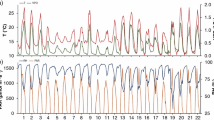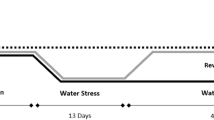Abstract
A dramatic decline in forest cover in eastern Africa along with a growing population means that timber and poles for building and fuelwood are in short supply. To overcome this shortage, the region is increasingly turning to eucalyptus. But eucalyptus raises environmental concerns of its own. Fears that it will deplete water supply, affect wildlife and reduce associated crop yields have caused many countries in the region to discourage farmers from planting this exotic. This paper is part of a series of investigations on the growth and water use efficiency of faster growing eucalyptus hybrids, which was introduced from South Africa to Kenya. The hypothesis is that the new hybrids are more efficient in using water and more suitable for the semi-arid tropics than existing eucalyptus and two popular agroforestry species. Gas exchange characteristics of juvenile Eucalyptus grandis (W. Hill ex Maiden), two eucalyptus hybrids (E. grandis × Eucalyptus camaldulensis Dehnh.), Grevillea robusta (A. Cunn) and Cordia africana (Lam) was studied under field and pot conditions using an infrared gas analyzer was used to measure photosynthetic active radiation (PAR), net photosynthetic rate (A), stomatal conductance (g s) and transpiration rate (E) at CO2 concentrations of 360 μmol mol−1 and ambient humidity and temperature. A, E and g s varied between species, being highest in eucalyptus hybrid GC 15 (24.6 μmol m−2 s−1) compared to eucalyptus hybrid GC 584 (21.0 μmol m−2 s−1), E. grandis (19.2 μmol m−2 s−1), C. africana (17.7 μmol m−2 s−1) and G. robusta (11.1 μmol m−2 s−1). C. africana exhibited high E values (7.0 mmol m−2 s−1) at optimal soil moisture contents than G. robusta (3.9 mmol m−2 s−1) and eucalyptus (5.3 mmol m−2 s−1) in field experiment and G. robusta (3.2 mmol m−2 s−1) and eucalyptus (4.2 mmol m−2 s−1) in pot-grown trees. At very low soil moisture content, extremely small g s values were recorded in GC 15 and E. grandis (8 mmol m−2 s−1) and G. robusta (14 mmol m−2 s−1) compared to GC 584 (46.9 mmol m−2 s−1) and C. africana (90.0 mmol m−2 s−1) indicating strong stomatal control by the species. Instantaneous water use efficiency ranged between 3 and 5 μmol mmol−1 and generally decreased with decline in soil moisture in pot-grown trees but increased with declining soil moisture in field-grown trees.





Similar content being viewed by others
References
Castrillo M, Fernandez D, Calcagno AM, Trujillo I, Guenni L (2001) Responses of ribulose-1, 5-bisphosphate carboxylase, protein content and stomatal conductance to water deficit in maize, tomato, and bean. Photosynthetica 39:221–226. doi:10.1023/A:1013731210309
Chaves MM, Pereira JS, Maroco J, Rodrigues ML, Ricardo CPP, Osorio ML et al (2002) How plants cope with water stress in the field: photosynthesis and growth. Ann Bot (Lond) 89:907–916. doi:10.1093/aob/mcf105
Chaves MM, Maroco J, Pereira J (2003) Understanding plant responses to drought from genes to the whole plant: a review. Funct Plant Biol 30:239–264. doi:10.1071/FP02076
Dufrene E, Pontaillier JY, Saugier B (1993) A branch bag measurement technique for simultaneous CO2 enrichment and assimilation measurement in beech (Fagus sylvatica L.). Plant Cell Environ 16:1131–1138. doi:10.1111/j.1365-3040.1996.tb02071.x
Eamus D (1999) Ecophysiological traits of deciduous and evergreen woody species in the seasonally dry tropics. Trends Ecol Evol 14:11–16. doi:10.1016/S0169-5347(98)01532-8
Eamus D, Myers B, Duff G, Williams D (1999) Seasonal changes in photosynthesis of eight savanna tree species. Tree Physiol 19:665–671
Field CB, Mooney HA (1986) The photosynthesis/nitrogen relationship in wild plants. In: Givnish TJ (ed) On economy of plant form and function. Cambridge University Press, London, pp 25–55
Freitas HMO (1996) Drought. In: Prasad NK (ed) Plant ecophysiology. Wiley, New York, 542 pp
Gindaba J, Rozanov A, Negash L (2004) Response of seedlings of two eucalyptus and three deciduous tree species from Ethiopia to severe water stress. For Ecol Manage 201:119–129. doi:10.1016/j.foreco.2004.07.009
Gindaba J, Rozanov A, Negash L (2005) Photosynthetic gas exchange, growth and biomass allocation of two eucalyptus and three indigenous tree species of Ethiopia under moisture deficit. For Ecol Manage 205:127–137. doi:10.1016/j.foreco.2004.10.056
Graciano C, Guiame’t JJ, Goya JF (2004) Impact of nitrogen and phosphorus fertilization on drought responses of Eucalyptus grandis seedlings. For Ecol Manage 212:40–49. doi:10.1016/j.foreco.2005.02.057
Hall DO, Scurlock JMO, Bolhar-Nordenkampf HR, Leegood RC, Long SP (1993) Photosynthesis and production in a changing environment; a field and laboratory manual. Chapman and Hall, New York, 464 pp
Jagger P, Pender J (2000) Role of trees for sustainable management of less-favoured lands: the case of eucalyptus in Ethiopia. Discussion paper No. 65. http://www.fpri.org/divs/eptd/dp/eptd65.html
Jagger P, Pender J (2005) The role of trees for sustainable management of less-favoured lands: the case of eucalyptus in Ethiopia. For Policy Econ 3(1):83–95
Kallarackal J, Somen CK (1997) An ecophysiological evaluation of the suitability of Eucalyptus grandis for planting in the tropics. For Ecol Manage 95:53–61. doi:10.1016/S0378-1127(97)00004-2
Koslowski TT, Pallardy SG (1997) Physiology of woody plants. Academic Press, London, pp 248–302
Kramer PJ, Boyer JS (1995) Water relations of plants and soils. Academic Press, USA, p 495
Kuyah S, Muthuri C, Ong CK (2008) Growth and water use of eucalyptus hybrids, Cordia africana and Grevillea robusta in semi-arid Kenya (Thika). East Afr J Bot (in press)
Larcher W (1995) Physiological plant ecology. Springer-Verlag, London, 303 pp
Muchena FH, Wamicha WN, Njoroge CRK (1978) Detailed survey of the Jomo Kenyatta College of Agriculture and Technology, Juja (Kiambu District). Soil survey report no. D13, Kenya soil survey, p 51
Muthuri CW (2004) Impact of agroforestry on crop performance and water resources in semi-arid central Kenya. PhD thesis, Jomo Kenyatta University of Agriculture and technology, Kenya, p 182
Myers JB, Theiveyanathan S, O’Brien ND, Bond WJ (1996) Growth and water use of Eucalyptus grandis and Pinus radiata plantations irrigated with effluent. Tree Physiol 16:211–219
O’grady PA, Eamus D, Hutley BL (1998) Transpiration increases during the dry season: patterns of tree water use in eucalypt open-forest of Northern Australia. Tree Physiol 19:591–597
Ottander C, Campbell D, Oquist G (1995) Seasonal-changes in photosystem-II organization and pigment composition in Pinus sylvestris. Planta 197:176–183. doi:10.1007/BF00239954
Pohjonen V (1989) Establishment of fuelwood plantations in Ethiopia. Silva Carelica 14, Joensuu University, Joensuu, Finland, 388 p
Radersma S, Ong CK, Coe R (2006) Water use of tree lines: importance of leaf area and micrometeorology in sub-hmud Kenya. Agrofor Syst 66:179–189. doi:10.1007/s10457-005-6643-3
Soares JV, Almeida CA (2001) Modeling the water balance and soil fluxes in a fast growing Eucalyptus plantation in Brazil. J Hydrol (Amst) 253:130–147. doi:10.1016/S0022-1694(01)00477-2
Wahid A, Rasul E, Rao RA, Iqbal RM (1997) Photosynthesis in leaf, stem, flower and fruit. In: Pessarakli M (ed) Handbook of photosynthesis. Marcel Dekker Inc, New York, pp 623–632
Whitehead D (1998) Regulation of stomatal conductance and transpiration in forest canopies. Tree Physiol 18:633–644
Whitehead D, Beadle CL (2004) Physiological regulation of productivity and water use in eucalyptus: a review. For Ecol Manage 193:113–140. doi:10.1016/j.foreco.2004.01.026
Yonas Y (2004) The Ethiopian experience in growing Eucalyptus. In: Ngamau C, Kanyi B, Epila-Otara J, Mwangingo P, Wakhusama S (eds) Towards optimizing the benefits of clonal forestry to small scale farmers in East Africa. ISAAA briefs no. 33. ISAAA, Ithaca. NY, p 20
Yordanov I, Velicova V, Tsonev A (2000) Plant responses to drought acclimation and stress tolerance. Photosynthetica 38:171–186. doi:10.1023/A:1007201411474
Acknowledgments
This publication is an output from a research project funded by JKUAT. We thank ICRAF for provision of equipment for the experiment and the Department of Botany for providing the plantation site.
Author information
Authors and Affiliations
Corresponding author
Rights and permissions
About this article
Cite this article
Shem, K., Catherine, M. & Ong, C. Gas exchange responses of Eucalyptus, C. africana and G. robusta to varying soil moisture content in semi-arid (Thika) Kenya. Agroforest Syst 75, 239–249 (2009). https://doi.org/10.1007/s10457-008-9176-8
Received:
Accepted:
Published:
Issue Date:
DOI: https://doi.org/10.1007/s10457-008-9176-8




